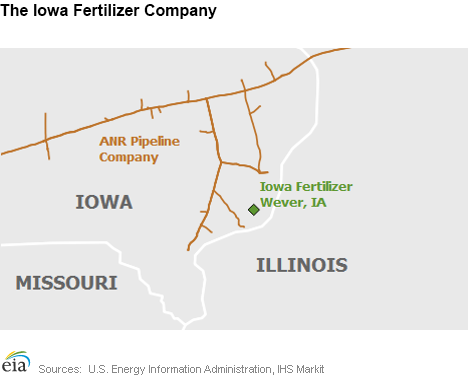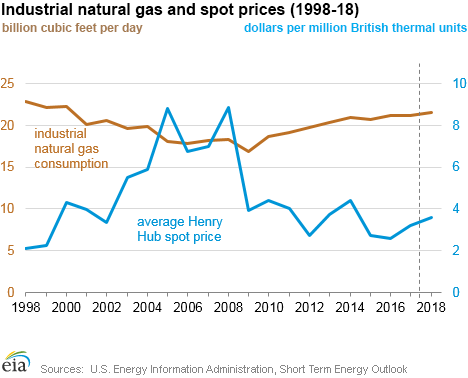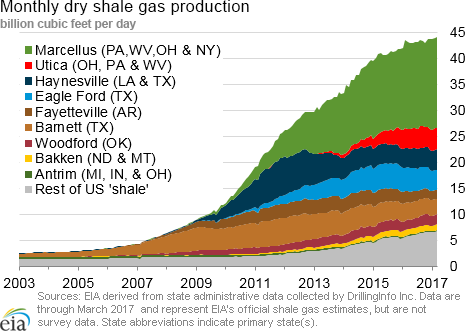In the News:
First world-scale, greenfield nitrogenous fertilizer plant opened in over 25 years
On April 19, the Iowa Fertilizer Company (IFCo) announced the start of production at its plant in Wever, Iowa. The $3 billion plant is estimated to produce 1.5 to 2 million metric tons (MMmt) of nitrogenous fertilizer products annually, using natural gas as both a feedstock and a fuel.
According to IFCo, it's Wever plant is the first world-scale, greenfield nitrogen fertilizer facility built in the United States in more than 25 years. IFCo's parent company, OCI N.V., produces natural gas-based fertilizers throughout the world and is based in the Netherlands. Foreign investment in the U.S. industrial sector is part of a growing trend in natural gas-intensive manufacturing, such as chemical manufacturing. One of the factors supporting this trend is an extended period of low U.S. natural gas prices, which have made it economical for companies to expand or construct new facilities.
The industrial sector as a whole—which includes methanol and ammonia (or urea-based fertilizer plants)—consumed an average of 21.2 billion cubic feet per day (Bcf/d) of natural gas in 2016, the highest amount since 2000. Natural gas consumption in this sector is forecast to rise in EIA's Short-Term Energy Outlook as new plants come online. In 2015, the United States produced 9.4 MMmt of ammonia—primarily for use as fertilizer—which is projected to grow by 47% through the end of the decade.
IFCo receives natural gas from the ANR pipeline, an interstate pipeline that transports natural gas from the South Central region to the Midwest region. According to EIA projections, IFCo will consume an estimated 0.13 Bcf/d of natural gas as feedstock to produce ammonia, which it can convert to produce nitrogenous fertilizer products. Each day, IFCo can produce up to 4,740 short tons of urea ammonium nitrate (UAN), 1,320 short tons of granular urea, 2,425 short tons of ammonia, and 990 short tons of diesel exhaust fluid. According to the company, they will be able to alternate between products on short notice to respond to market demand.
These chemicals can be stored on site or delivered to agricultural and other markets via truck and rail and, potentially, barge because of the plant's proximity to the Mississippi River. In particular, the nitrogenous fertilizer products can be delivered to nearby markets in Illinois, Indiana, Iowa, Missouri, Nebraska, and Ohio.
Overview:
(For the Week Ending Wednesday, May 3, 2017)
- Natural gas spot prices rose at most locations this report week (Wednesday, April 26 to Wednesday, May 3). The Henry Hub spot price rose from $3.02 per million British thermal units (MMBtu) last Wednesday to $3.09/MMBtu yesterday.
- At the New York Mercantile Exchange (Nymex), the May 2017 contract expired last Wednesday at $3.142/MMBtu. The June 2017 contract price decreased to $3.228/MMBtu, down 4¢ Wednesday to Wednesday.
- Net injections to working gas totaled 67 billion cubic feet (Bcf) for the week ending April 28. Working natural gas stocks are 2,256 Bcf, which is 14% lower than the year-ago level and 16% higher than the five-year (2012–16) average for this week.
- The natural gas plant liquids composite price at Mont Belvieu, Texas, fell by 16¢, averaging $5.95/MMBtu for the week ending May 3. The price of natural gasoline, propane, butane, and isobutane fell by 4%, 5%, 2%, and 2%, respectively. The price of ethane rose by 2%.
- According to Baker Hughes, for the week ending Friday, April 28, the natural gas rig count increased by 4 to 171. The number of oil-directed rigs rose by 9 to 697. The total rig count increased by 13, and it now stands at 870.
Prices/Supply/Demand:
Republished 5/8/2017 to correct erroneous data from PointLogic.
Prices rise slightly. This report week (Wednesday, April 26 to Wednesday, May 3), the Henry Hub spot price rose 7¢ from $3.02/MMBtu last Wednesday to $3.09/MMBtu yesterday. At the Chicago Citygate, prices increased 1¢ from $2.93/MMBtu last Wednesday to $2.94/MMBtu yesterday. Prices at PG&E Citygate in Northern California stayed level week over week at $3.27/MMBtu. The price at SoCal Citygate rose 7¢ from $3.10/MMBtu last Wednesday to $3.17/MMBtu yesterday.
Northeast prices rise. Northeast prices rose as forecasts began predicting cooler weather. At the Algonquin Citygate, which serves Boston-area consumers, prices rose 13¢ from $3.16/MMBtu last Wednesday to $3.29/MMBtu yesterday, after a mid-week low of $2.77/MMBtu on Friday. Other Northeast price points had larger, steadier increases. The Transcontinental Pipeline Zone 6 trading point for New York saw prices increase 29¢ from $2.56/MMBtu last Wednesday to $2.85/MMBtu yesterday. Tennessee Zone 4 Marcellus spot prices advanced 25¢ from $2.42/MMBtu last Wednesday to $2.67/MMBtu yesterday. At Dominion South in northwest Pennsylvania, spot prices rose 29¢ from $2.47/MMBtu last Wednesday to $2.76/MMBtu yesterday.
June contract prices decrease. At the Nymex, the May 2017 contract expired last Wednesday at $3.142/MMBtu. The June 2017 contract decreased to $3.228/MMBtu, down 4¢ from last Wednesday to yesterday. The price of the 12-month strip averaging June 2017 through May 2018 futures contracts declined 5¢ to $3.323/MMBtu.
Maintenance on U.S. export pipeline to Canada increases U.S. supply. According to data from PointLogic, the average total supply of natural gas rose by 2% compared with the previous week. While dry natural gas production remained constant week over week, average net imports from Canada increased by 17% from last week. This rise in net imports resulted from a decrease in U.S. exports to Canada: the Vector Pipeline, which begins southwest of Chicago and runs to Dawn Hub in Ontario, began maintenance on May 1 that is restricting export flows by more than 1 Bcf/d. This maintenance is to support an interconnection with the under-construction Rover Pipeline.
Demand rises. Total natural gas demand, which includes export volumes to Mexico, rose by 4% compared with the previous report week, while total U.S. consumption of natural gas rose by 3%, according to data from PointLogic. Power burn climbed by 9% week over week. Industrial sector consumption stayed constant, averaging 20.4 Bcf/d. In the residential and commercial sectors, consumption declined by 2%. Natural gas exports to Mexico increased 16%.
Pipeline deliveries to U.S. liquefied natural gas (LNG) terminals increase. Natural gas pipeline deliveries to the Sabine Pass liquefaction terminal averaged 2.0 Bcf/d for the report week, 9% higher than in the previous week. Three vessels (combined LNG-carrying capacity of 10.4 Bcf) departed Sabine Pass last week (Thursday to Wednesday), and one vessel (LNG-carrying capacity of 3.8 Bcf) was loading at the terminal on Wednesday, May 3.
Storage:
Mild temperatures result in higher-than-average net injections into working gas storage. Net injections into storage totaled 67 Bcf, compared with the five-year (2012–16) average net injection of 63 Bcf and last year's net injections of 68 Bcf during the same week. Net injections exceeded the five-year average in the East, Midwest, and Mountain regions by 9 Bcf on the week. Elsewhere, net injections fell below the five-year average.
Working gas levels are 14% lower than last year's record levels, but well ahead of the five-year average. Working gas levels are 359 Bcf lower than last year's levels at this time. This year-over-year deficit prevails in each of the regions of the Lower 48 states. The South Central region has the largest year-over-year deficit—135 Bcf. The East region has the largest deficit in relative terms, at 126 Bcf, 27% of last year's stock level. The Midwest region is 45 Bcf lower than last year at this time and the Pacific region is 50 Bcf lower than last year's level. In contrast, working gas levels are 303 Bcf higher than the five-year average in the Lower 48 states and are higher than the five-year average in all regions except the East and the Pacific regions, which are 49 Bcf and 16 Bcf lower than the five-year average, respectively. The South Central region accounts for 220 Bcf of the surplus compared with the five-year average, and the Midwest region is 120 Bcf higher than the five-year average.
The January futures price is trading at a premium over the current spot price, but well behind last year's level at this time. During the most recent storage week, the average natural gas spot price at the Henry Hub was $3.01/MMBtu, while the Nymex futures price of natural gas for delivery in January 2018 averaged $3.59/MMBtu, a difference of 57¢. The premium was $1.22 a year ago. The price premium provides incentives for continued injections of natural gas into storage.
Reported net injections were within range of market expectations for the week. According to the Bloomberg survey of natural gas analysts, estimates of net injections to working natural gas storage ranged from 53 Bcf to 72 Bcf, with a median of 61 Bcf. Prices of the Nymex futures contracts for June 2017 delivery at Henry Hub decreased 3¢/MMBtu to $3.19/MMBtu in 297 trades at the release of the Weekly Natural Gas Storage Report (WNGSR). Prices varied in subsequent trading, centered on $3.20/MMBtu.
Temperatures were higher than normal and cooler than last year in most parts of the Lower 48 states. Temperatures in the Lower 48 states averaged 58°F, 2°F higher than the normal and 1°F lower than last year at this time. This pattern prevailed in all regions of the Lower 48 states except the West North Central and South Central Census Divisions.
See also:
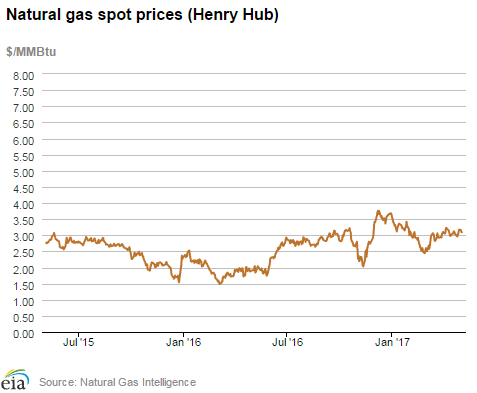
| Spot Prices ($/MMBtu) | Thu, 27-Apr |
Fri, 28-Apr |
Mon, 01-May |
Tue, 02-May |
Wed, 03-May |
|---|---|---|---|---|---|
| Henry Hub |
3.07 |
3.17 |
3.17 |
3.11 |
3.09 |
| New York |
2.53 |
2.67 |
2.80 |
2.83 |
2.85 |
| Chicago |
2.91 |
2.92 |
2.99 |
2.96 |
2.94 |
| Cal. Comp. Avg.* |
2.93 |
3.00 |
2.98 |
2.94 |
2.96 |
| Futures ($/MMBtu) | |||||
| June Contract | 3.239 |
3.276 |
3.215 |
3.195 |
3.228 |
| July Contract |
3.320 |
3.353 |
3.293 |
3.274 |
3.309 |
| *Avg. of NGI's reported prices for: Malin, PG&E Citygate, and Southern California Border Avg. | |||||
| Source: NGI's Daily Gas Price Index | |||||
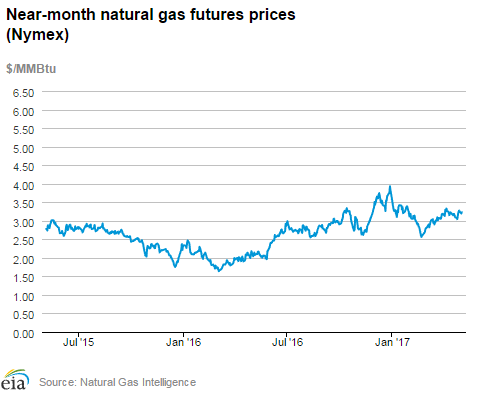
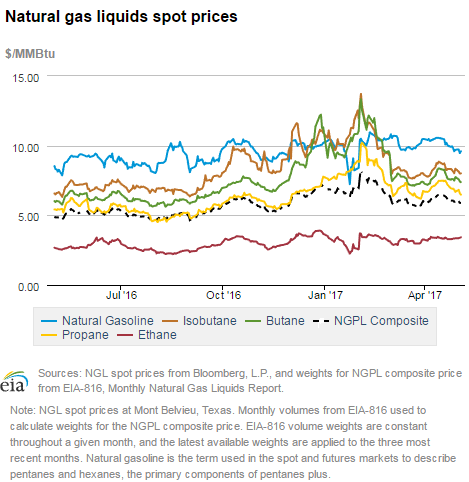
| U.S. natural gas supply - Gas Week: (4/27/17 - 5/3/17) | |||
|---|---|---|---|
Average daily values (Bcf/d): |
|||
this week |
last week |
last year |
|
| Marketed production | 78.9 |
78.6 |
81.2 |
| Dry production | 70.0 |
69.8 |
72.3 |
| Net Canada imports | 6.0 |
5.1 |
5.9 |
| LNG pipeline deliveries | 0.0 |
0.0 |
0.3 |
| Total supply | 76.0 |
74.8 |
78.5 |
|
Source: OPIS PointLogic Energy, an IHS Company | |||
| U.S. natural gas consumption - Gas Week: (4/27/17 - 5/3/17) | |||
|---|---|---|---|
Average daily values (Bcf/d): |
|||
this week |
last week |
last year |
|
| U.S. consumption | 57.7 |
56.0 |
62.8 |
| Power | 24.7 |
22.7 |
26.1 |
| Industrial | 20.4 |
20.5 |
20.5 |
| Residential/commercial | 12.6 |
12.8 |
16.2 |
| Mexico exports | 4.1 |
3.6 |
3.5 |
| Pipeline fuel use/losses | 6.2 |
5.8 |
6.6 |
| LNG pipeline receipts | 2.1 |
1.9 |
0.0 |
| Total demand | 70.1 |
67.2 |
73.0 |
|
Source: OPIS PointLogic Energy, an IHS Company | |||
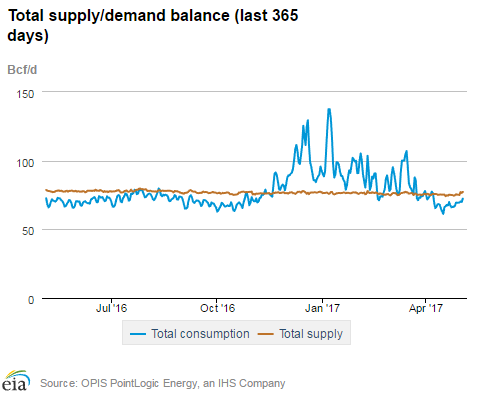
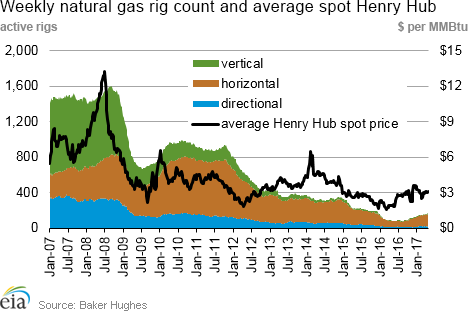
| Rigs | |||
|---|---|---|---|
Fri, April 28, 2017 |
Change from |
||
last week |
last year |
||
| Oil rigs | 697 |
1.3% |
109.9% |
| Natural gas rigs | 171 |
2.4% |
96.6% |
| Note: Excludes any miscellaneous rigs | |||
| Rig numbers by type | |||
|---|---|---|---|
Fri, April 28, 2017 |
Change from |
||
last week |
last year |
||
| Vertical | 77 |
-2.5% |
54.0% |
| Horizontal | 730 |
1.7% |
125.3% |
| Directional | 63 |
5.0% |
37.0% |
| Source: Baker Hughes Inc. | |||
| Working gas in underground storage | ||||
|---|---|---|---|---|
Stocks billion cubic feet (Bcf) |
||||
| Region | 2017-04-28 |
2017-04-21 |
change |
|
| East | 325 |
303 |
22 |
|
| Midwest | 519 |
504 |
15 |
|
| Mountain | 153 |
149 |
4 |
|
| Pacific | 233 |
228 |
5 |
|
| South Central | 1,026 |
1,005 |
21 |
|
| Total | 2,256 |
2,189 |
67 |
|
| Source: U.S. Energy Information Administration | ||||
| Working gas in underground storage | |||||
|---|---|---|---|---|---|
Historical comparisons |
|||||
Year ago (4/28/16) |
5-year average (2012-2016) |
||||
| Region | Stocks (Bcf) |
% change |
Stocks (Bcf) |
% change |
|
| East | 451 |
-27.9 |
374 |
-13.1 |
|
| Midwest | 564 |
-8.0 |
399 |
30.1 |
|
| Mountain | 157 |
-2.5 |
124 |
23.4 |
|
| Pacific | 283 |
-17.7 |
249 |
-6.4 |
|
| South Central | 1,161 |
-11.6 |
806 |
27.3 |
|
| Total | 2,615 |
-13.7 |
1,953 |
15.5 |
|
| Source: U.S. Energy Information Administration | |||||
| Temperature – heating & cooling degree days (week ending Apr 27) | ||||||||
|---|---|---|---|---|---|---|---|---|
HDD deviation from: |
CDD deviation from: |
|||||||
| Region | HDD Current |
normal |
last year |
CDD Current |
normal |
last year |
||
| New England | 99 |
-12 |
10 |
0 |
0 |
0 |
||
| Middle Atlantic | 75 |
-20 |
10 |
1 |
1 |
1 |
||
| E N Central | 70 |
-28 |
6 |
1 |
1 |
1 |
||
| W N Central | 106 |
18 |
43 |
0 |
-2 |
-3 |
||
| South Atlantic | 28 |
-15 |
7 |
31 |
11 |
5 |
||
| E S Central | 27 |
-12 |
13 |
12 |
5 |
-4 |
||
| W S Central | 23 |
8 |
15 |
33 |
5 |
-9 |
||
| Mountain | 94 |
-3 |
21 |
12 |
1 |
1 |
||
| Pacific | 39 |
-18 |
-9 |
0 |
-4 |
-1 |
||
| United States | 60 |
-13 |
10 |
11 |
1 |
0 |
||
|
Note: HDD = heating degree day; CDD = cooling degree day Source: National Oceanic and Atmospheric Administration | ||||||||
Average temperature (°F)
7-Day Mean ending Apr 27, 2017
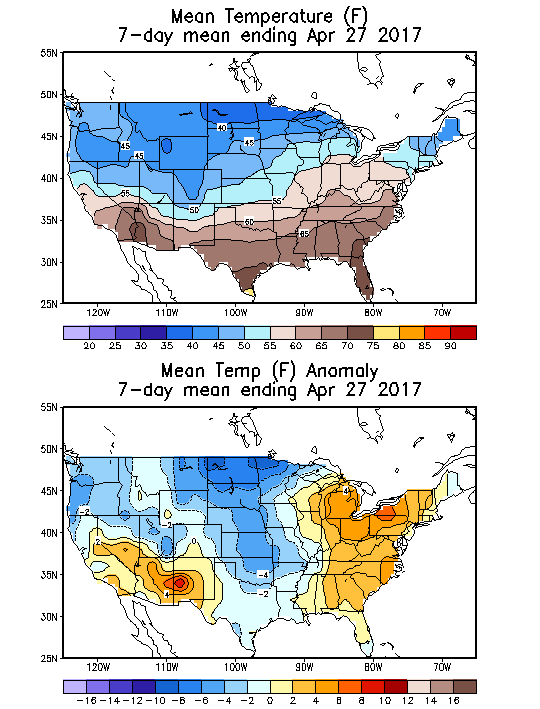
Source: NOAA National Weather Service
Deviation between average and normal (°F)
7-Day Mean ending Apr 27, 2017

Source: NOAA National Weather Service

